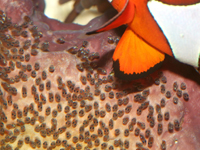

 |

|
 Clownfish |
Clownfish(Fish) |
 Clownfish Baby |
Clownfish HabitsClownfish belong to a group of small, brightly colored fish called damselfish. These inshore reef dwellers have developed a curious and potentially deadly relationship with the sea anemone.
Far too small to be hunted by man for food, clownfish have lived undisturbed in the coral reefs for thousands of years. But more recently, they have become extremely popular as saltwater aquarium fish. The brightly colored species command a high price in europe and the united states. Collectors, realizing the demand, have destroyed many reefs in search of prime specimens, often damaging or killing the host anemones in the process.
Fortunately, many local governements have imposed restrictions on the number of the clownfish that can be taken from their habitats and the means by which they can be taken. And, because clownfish are a big attraction with snorkelers and scuba divers, the tourist industry has an interest in protecting them and ensuring that they be allowed to live and breed safely on the reefs. |
Clownfish CommunicationClownfish communicate by making chirps and pops that they use to warn off rivals or lure mateswhich sounds like the creaking of an old door-hinge.
The clownfish, like many of their piscine brethren, use the sounds creatively but make them in a unique way. Whereas most other fish use swim bladders or rub their bones together to vocalize, clownfish prefer to raise their heads, shuffle the bones in their mouths and close their jaws. Slamming teeth together produces the noise that is then radiated by the jaws of all 27 varieties of the species. Its not exactly the tears of a clown
fish, more like the teeth-grinding of a clownfish as a pickup line. But its still music to their mates. |
Clownfish BreedingClownfish lay their eggs in batches on the clear coral or rock adjacent to the anemone, or at the base of the male guards the eggs until they hatch 4-5 days later. In some species of clownfish, the male cares for the young until they reach sexual maturity, at which time they leave to find their own host anemone.
Most clownfish spawn on coral near their host anemone or within the anemone itself. |
Clownfish Food & Feeding The clownfish has a symbiotic, or mutually beneficial, relationship with the sea anemone. It catches most of its food by cooperating with its host anemone. The clownfish will leave the safety of the anemone's tentacles and swim out among the nearby reef. Its brilliant colors attract larger fish, who, lured by the thought of a meal, follow it back to the anemone and are stung by the anemone one's tentacles. The anemone then consumes the fish, and the clownfish feeds on the remains.
In addition to other fish, the clownfish also feeds on planktonic crustaceans and algae that live in or grow on the reef. The clownfish also eats away debris and nibbles off the dead tentacles of its host anemone. |
Clownfish Key Facts |
| Size |
| Height: Length: 3-6 inches, according to species |
| Weight: Up to 1 pound |
| Breeding |
| Sexual maturity: Unknown |
| Mating: Year round in tropical waters |
| Gestation: Hatching time: 4-5 days |
| Number of young: Eggs are laid in large batches |
| Lifestyle |
| Habit: Usually live in pairs within an anemone |
| Diet: Leftovers from fish consumed by anemone; algae |
| Lifespan: 3-6 years in captivity |
DID YOU KNOW?
|
CAN'T FIND WHAT YOU'RE LOOKING FOR? CLICK HERE!!!